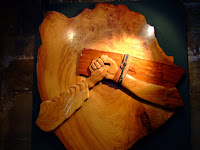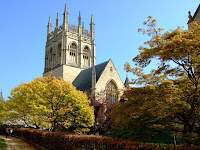 On Sunday we visited a number of attractions around the very attractive town of Bradford-on-Avon.
On Sunday we visited a number of attractions around the very attractive town of Bradford-on-Avon.The first was Farleigh Hungerford, south of the town. After the unique experience (for us) of driving through a medieval gatehouse, just beyond a large moat (we could imagine the draw bridge) we toured the ruins of the Castle.
 All that remains intact is the priest house and Chapel complete with tombs, unique wall paintings and Crypt containing lead death masks on coffins of the lesser 16th and 17th century Hungerfords.
All that remains intact is the priest house and Chapel complete with tombs, unique wall paintings and Crypt containing lead death masks on coffins of the lesser 16th and 17th century Hungerfords.There were interesting stories about the castle, the one we found most interesting was the wife of the
 chief steward who murdered her husband and disposed of him in the large kitchen oven, so that she could then marry the Lord of the Manor.
chief steward who murdered her husband and disposed of him in the large kitchen oven, so that she could then marry the Lord of the Manor.Following this, we visited The Courts Gardens: they were bursting with new spring growth and colours; and we saw our first wisteria of the day, climbing up the house.
 Back into Bradford-on-Avon to visit the impressive Tithe Barn where the majority of the timber beams holding up the massive roof are 650 years old. Find a big oak with just the right bend and you have a ready-made arch-beam that will last for centuries!
Back into Bradford-on-Avon to visit the impressive Tithe Barn where the majority of the timber beams holding up the massive roof are 650 years old. Find a big oak with just the right bend and you have a ready-made arch-beam that will last for centuries! A pleasant walk along the River Avon took us into the town. Although much smaller than nearby Bath, it is still well worth a visit. A canal also flows though the town and we were able to enjoy the spring sunshine on a loop track along the river, and back via the canal.
A pleasant walk along the River Avon took us into the town. Although much smaller than nearby Bath, it is still well worth a visit. A canal also flows though the town and we were able to enjoy the spring sunshine on a loop track along the river, and back via the canal. By this time, Westwood Manor was due to open, so we headed south again. The earliest parts of this house date back to 983. The house is small, very liveable (still lived in by a tenant) and a fascinating time shot of history, having been restored in the early 20th century to be as it was in the 17th century. The garden has a topiary representation of the missing west wing.
By this time, Westwood Manor was due to open, so we headed south again. The earliest parts of this house date back to 983. The house is small, very liveable (still lived in by a tenant) and a fascinating time shot of history, having been restored in the early 20th century to be as it was in the 17th century. The garden has a topiary representation of the missing west wing.
Our final visit of the day was the best. The Peto Garden at Iford Manor is inspiring: once again, with a magnificent display of wisterias. The garden has been laid out in an Italian style. Colour, shapes, interesting layout, water features, pools, fountains, colonnades, it has it all. Not only is the garden wonderful, the position would be hard to beat.
 At the bottom of a sheltered valley, complete with a river flowing past the front gate and a picturesque bridge with a built-in seat nook.
At the bottom of a sheltered valley, complete with a river flowing past the front gate and a picturesque bridge with a built-in seat nook.The long spring day begged us to do one more walk on the way home, but despite thatched cottages and an disproportionately large, for the size of the village, Cathedral style church - we had been so visually over loaded at the Peto Garden that the walk based around the village
 of Bishops Canning was actually an anticlimax. But in fairness, it had quite the perfect ‘job description’ for a walk: past a beautiful church and thatched cottages, alongside rape fields in full bloom, across a grassy meadow, along a canal towpath, crossing back via a swing bridge and past a final thatched cottage to the start.
of Bishops Canning was actually an anticlimax. But in fairness, it had quite the perfect ‘job description’ for a walk: past a beautiful church and thatched cottages, alongside rape fields in full bloom, across a grassy meadow, along a canal towpath, crossing back via a swing bridge and past a final thatched cottage to the start.
















































